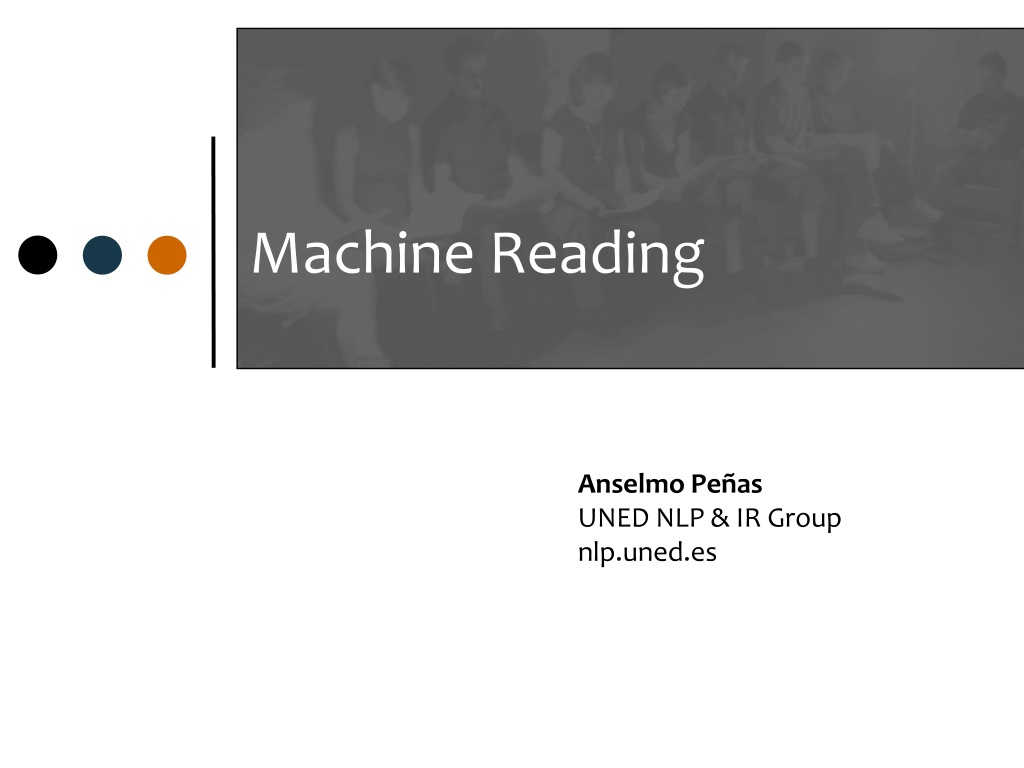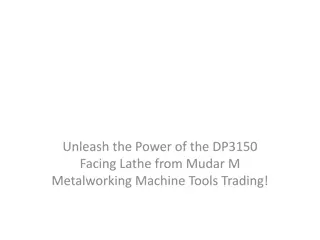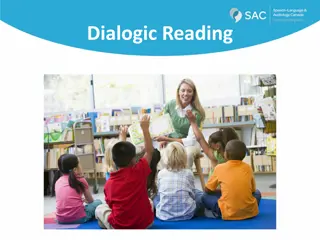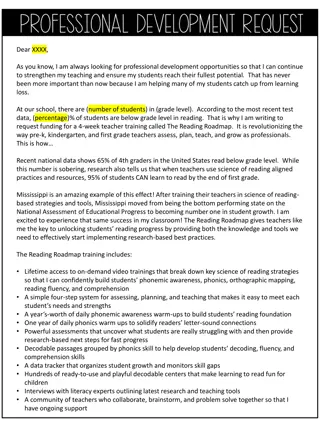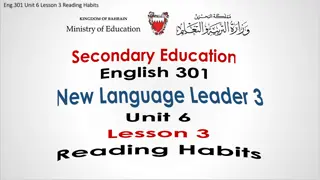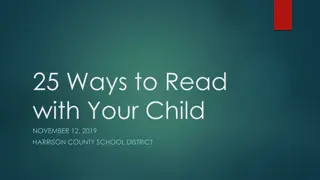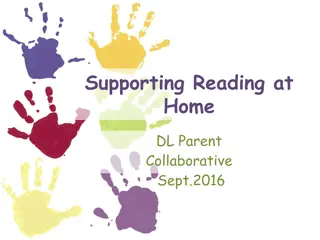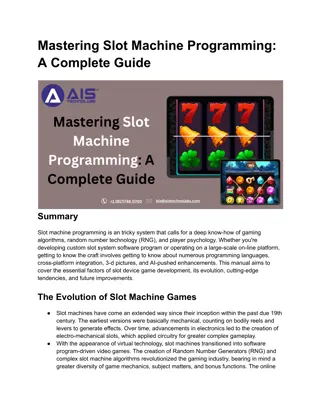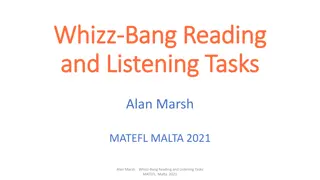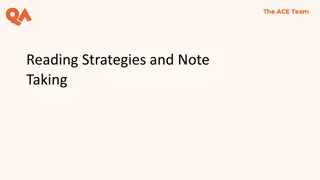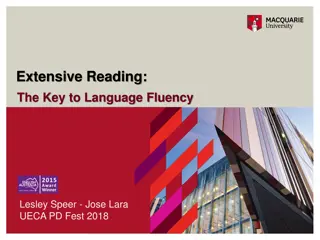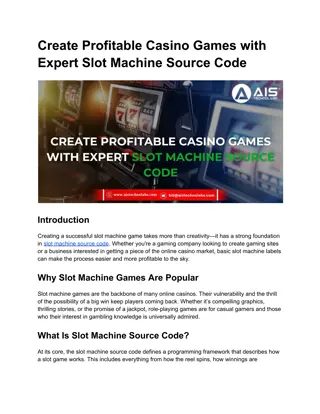Exploring Machine Reading and Language Understanding at UNED
Delve into the realm of machine reading and language understanding with insights from UNED's NLP & IR Group. The discussion covers the significance of understanding language, the role of knowledge in comprehension, testing acquired knowledge, and the evolution towards machine-operable representations of texts. Discover the shift in computational semantics paradigms, emphasizing statistical distributions over symbols, and the immense potential of automating knowledge manipulation.
Download Presentation

Please find below an Image/Link to download the presentation.
The content on the website is provided AS IS for your information and personal use only. It may not be sold, licensed, or shared on other websites without obtaining consent from the author. Download presentation by click this link. If you encounter any issues during the download, it is possible that the publisher has removed the file from their server.
E N D
Presentation Transcript
Machine Reading Anselmo Pe as UNED NLP & IR Group nlp.uned.es
UNED What s this talk about? Why are we so good understanding language? nlp.uned.es
UNED What s this talk about? To know Be aware of a specific piece of information So you can use it In particular, to understand language. To understand language Make sense of language (interpret) So you convert it into a piece of information that you are aware of. nlp.uned.es
UNED Knowledge - Understanding dependence We understand because we know Capture Background Knowledge from text collections Understand language Reading cycle nlp.uned.es
UNED What s this talk about? How to test knowledge? How to test knowledge acquired through language? Answering Questions nlp.uned.es
UNED Outline Machine Reading Limitations of supervised Information Extraction From Micro-reading to Macro-reading: the semi- supervised approach Open Machine Reading: the unsupervised approach Inference with Open Knowledge Evaluation 1. 2. 3. 4. 5. 6. nlp.uned.es
UNED Reading Machine Structured Query Answer Text Reasoning Machine Reading Machine A machine that produces machine operable representations of texts nlp.uned.es
UNED Why a Reading Machine? The majority of human knowledge is encoded in text Much of this text is available in machine-readable formats Finding machine operable representations of texts opens the door to the automatic manipulation of vast amounts of knowledge There is a big industry awaiting this event nlp.uned.es
UNED Why now? A change in the paradigms of Computational Semantics 1. Conceptualizing content is not in the form of symbols but in the form of statistical distributions The power to capture the huge amount of background knowledge needed to read a single document 2. nlp.uned.es
UNED Machine Reading Program Phase II first attempt Target Ontology Representation according to the Target Ontology Textual Documents Reading Machine Reasoning Machine Questions and Answers are expressed according to a Target Ontology Query Answer The Target Ontology changes with the domain Ideally, is an input to the MR system nlp.uned.es
UNED Representation for reasoning Player Event_Game homeTeam Team Event_Scoring hasProperty awayTeam Measure hasProperty Target Ontology Event_Play Score Event_Final_Scoring loosingScore winningScore nlp.uned.es
UNED Query in a Target Ontology Query 20011: Who killed less than 35 people in Kashmir? :- 'HumanAgent'(FileName, V_y), killingHumanAgent(FileName, V_x, V_y), 'HumanAgentKillingAPerson'(FileName, V_x), personGroupKilled(FileName, V_x, V_group), 'PersonGroup'(FileName, V_group), 'Count'(FileName, V_count), value(FileName, V_count, 35), numberOfMembersUpperBound(FileName, V_group, V_count), eventLocationGPE(FileName, V_x, 'Kashmir'). nlp.uned.es
UNED Representation gap Target Ontology is oriented to express the QA language An extension is needed to enable reasoning: Reasoning Ontology Both are far from text We need several levels of intermediate representations And mappings between them nlp.uned.es
UNED Mapping between representations Textual Documents Reading Representation Reasoning Representation QA Representation Reading Ontology Reasoning Ontology Target Ontology Domain independent Domain dependent Domain dependent nlp.uned.es
UNED Outline Machine Reading Limitations of supervised Information Extraction From Micro-reading to Macro-reading: the semi- supervised approach Open Machine Reading: the unsupervised approach Inference with Open Knowledge Evaluation 1. 2. 3. 4. 5. 6. nlp.uned.es
UNED Reading Machine v.1 Information Extraction Supervised Learning Textual Documents Reading Representation Reasoning Representation QA Representation Categories and relations used by the IE engine Reading Ontology Reasoning Ontology Target Ontology nlp.uned.es
UNED Supervised IE Learn a direct mapping between the text and the ontology Categories/classes, instances Relations Need of many annotated examples For each category, relation For each domain Speed up annotation Active Learning nlp.uned.es
UNED Not good enough Conjunctive queries Query performance is product of IE performance for each entity and relation in the query IE F1 Entities and relations in the query 0.9 'HumanAgent'(FileName, V_y), 0.8 killingHumanAgent(FileName, V_x, V_y), 0.9 'HumanAgentKillingAPerson'(FileName, V_x), 0.8 personGroupKilled(FileName, V_x, V_group), 0.9 'PersonGroup'(FileName, V_group), 'Count'(FileName, V_count), value(FileName, V_count, 35), numberOfMembersUpperBound(FileName, V_group, V_count), 0.9 eventLocationGPE(FileName, V_x, 'Kashmir'). 0.42 Upper bound Performance Will the Reasoning Machine recover from that? nlp.uned.es
UNED Local versus Global Good performance in local decisions is not enough Texts are never 100% explicit Relations are expressed in unlearned ways You ll miss some relations Critical in conjunctive queries nlp.uned.es
UNED Local versus Global We need global approaches Joint models? E.g.: NER and Relation Extraction? Still inside a single document Can we leverage redundancy in millions of documents? nlp.uned.es
UNED Outline Machine Reading Limitations of supervised Information Extraction From Micro-reading to Macro-reading: the semi- supervised approach Open Machine Reading: the unsupervised approach Inference with Open Knowledge Evaluation 1. 2. 3. 4. 5. 6. nlp.uned.es
UNED Local versus Global What do we want? Extract facts from a single given document? Micro-reading Why a single doc? Depends on the final application scenario Or do we want just extract facts? E.g. populate ontologies Then, Can we leverage redundancy? nlp.uned.es
UNED Macro-reading (Tom Mitchell) Leverage redundancy on the web Target reading to populate a given ontology Use coupled semi-supervised learning algorithms Seed learning using Freebase, DBpedia nlp.uned.es
UNED Semi-supervised Bootstrap Bootstrapping Start with few seeds Find some patterns Obtain new seeds Find new patterns Degenerates fast nlp.uned.es
UNED Semi-Supervised Bootstrap Learning Extract cities: anxiety selfishness Berlin Paris Pittsburgh Seattle Cupertino San Francisco Austin denial Seeds / instances patterns mayor of arg1 live in arg1 arg1 is home of traits such as arg1 Example from Tom Mitchell nlp.uned.es
UNED Alternative 1: coupled learning Coupled semi-supervised learning Category/class and relation extractors Cardinality of the relation Compatible / mutual exclusive categories Category subset / superset / orthogonal nlp.uned.es
UNED Alternative 1: coupled learning Examples Category and relation extractors John, lecturer at the Open University, One classifier Lecturer at -> employee_of Three coupled classifiers John -> type_employee Open University -> type_company Lecturer at -> employee_of(type_employee, type_company) nlp.uned.es
UNED Alternative 1: coupled learning Examples Cardinality of the relation Cardinality(spouse(x,y,timestamp))={0,1} If cardinality is 1 Chose most probable as positive example Use the rest as negative examples nlp.uned.es
UNED Alternative 2: More seeds Freebase DBPedia No bootstrap Learn models instead of patterns Use in combination with coupling nlp.uned.es
UNED Reading attached to the ontology Micro-reading take advantage of the ontology Known instances and their categories Subset /superset relations Typed relations Macro-reading is beyond the sum of micro-readings Coupling nlp.uned.es
UNED Drop the ontology? But, What do we want? Populate ontologies? Depends on the target application Or increase the number of beliefs available to our machine? Must those beliefs be targeted to an ontology? nlp.uned.es
UNED Ontologies Artificial Predefined set of categories and relations loosingTeam eventFinalScoring Maybe too far from natural language Impossible mapping without some supervision nlp.uned.es
UNED Ontologies Enable formal inference Specific-domain knowledge-based inferences Pre-specified with lots of human effort Machine assisted Are they all the inferences we need? Not for the purposes of reading nlp.uned.es
UNED Outline Machine Reading Limitations of supervised Information Extraction From Micro-reading to Macro-reading: the semi- supervised approach Open Machine Reading: the unsupervised approach Inference with Open Knowledge Evaluation 1. 2. 3. 4. 5. 6. nlp.uned.es
UNED So far From IE to Machine Reading Corpus C Background beliefs B Yield a renewed set of beliefs B Reading(C) + B -> B Use B for inference in next reading cycle nlp.uned.es
UNED Drop the Ontology So, What if there is no target ontology? How to express / represent beliefs? How to make inferences? nlp.uned.es
UNED Toward Open Machine Reading Open Knowledge Extraction (Schubert) KNEXT Open Information Extraction (Etzioni) TextRunner Followers DART (P. Clark) BKB (A. Pe as) IBM PRISMATIC (J. Fan) nlp.uned.es
UNED Toward Open Machine Reading How to represent beliefs? We shouldn t ignore what Reasoning Machines are used to work with nlp.uned.es
UNED Representation I like graphs I can make graphs! Well Do you like syntactic dependencies? Question Answer Reasoning Machine ? Reading Machine Text Reasoning Ontology Target Ontology nlp.uned.es
UNED Representation Are typed syntactic dependencies a good starting point? Is it possible to develop a set of semantic dependencies ? How far can we go with them? Could we share them across languages? What s a semantic dependence? A probability distribution? Can we have a representation of the whole document instead sentence by sentence? nlp.uned.es
UNED What else? Silly I like entities and classes What about person / organization / location / other? I have entities and classes! machine Question Answer Reasoning Machine ? Reading Machine Text Reasoning Ontology Target Ontology nlp.uned.es
UNED Classes Easy ones Not easy ones Entity The rest of words Named Person Organization Location Other Date Time Measure Distance Weight Height Other (almost) Skip all philosophical argue nlp.uned.es
UNED Classes Sure! This is about US football Can you help me? Great Question Answer Reasoning Machine ? Reading Machine Text Maybe I should read something about US football Reasoning Ontology Target Ontology nlp.uned.es
UNED Classes from text Do texts point out classes? Of course What classes? The relevant classes for reading Uhm this could be interesting Just small experiment: Parse 30,000 docs. about US football Look for these dependencies NNP NNP NNP nn appos be NN NN NN nlp.uned.es
UNED Most frequent has-instance 334:has_instance:[quarterback:n, ('Kerry':'Collins'):name]. 306:has_instance:[end:n, ('Michael':'Strahan'):name]. 192:has_instance:[team:n, 'Giants':name]. 178:has_instance:[owner:n, ('Jerry':'Jones'):name]. 151:has_instance:[linebacker:n, ('Jessie':'Armstead'):name]. 145:has_instance:[coach:n, ('Bill':'Parcells'):name]. 139:has_instance:[receiver:n, ('Amani':'Toomer'):name]. nlp.uned.es
UNED Most frequent classes 15457 quarterback 12395 coach 7865 end 7611 receiver 6794 linebacker 4348 team 4153 coordinator 4127 player 4000 president 3862 safety 3722 cornerback 3479 (wide:receiver) 3344 (defensive:end) 3265 director 3252 owner 2870 (tight:end) 2780 agent 2291 guard 2258 pick 2177 manager 2138 (head:coach) 2082 rookie 2039 back 1985 (defensive:coordinator) 1882 lineman 1836 (offensive:coordinator) 1832 tackle 1799 center 1776 (general:manager) 1425 fullback 1366 (vice:president) 1196 backup 1193 game 1140 choice 1102 starter 1100 spokesman 1083 (free:agent) 1006 champion 990 man 989 son 987 tailback nlp.uned.es
UNED Classes from text Find more ways to point out a class in text? Now you have thousands of seeds Bootstrap! But remember, coupled nlp.uned.es
UNED Classes What a mess! Flat, redundant ! Where are gameWinner, safetyPartialCount, ? I have these classes! What? Question Answer Reasoning Machine ? Reading Machine Text Reasoning Ontology Target Ontology nlp.uned.es
UNED Relations Ok, let s move on Show me the relations you have gameWinner a class!? Come on! Relations? Question Answer Reasoning Machine ? Reading Machine Text Reasoning Ontology Target Ontology nlp.uned.es
UNED Relations Tom, ehm What s a relation? Well certainly, a relation is a n-tuple ... n-tuple Like verb structures? Uhm this could be interesting Just small experiment: Take the 30,000 docs. about US football and look for: VB VB arg0 prep arg0 arg1 arg1 NN NN NN NN NN nlp.uned.es
